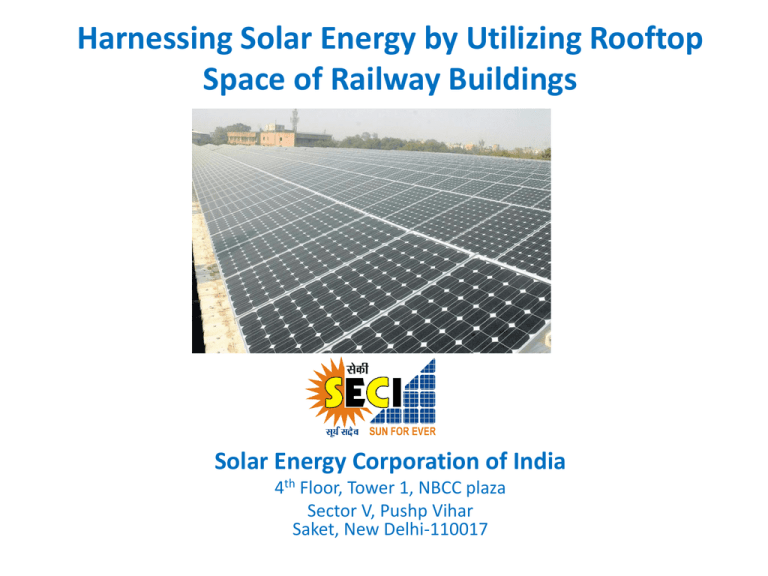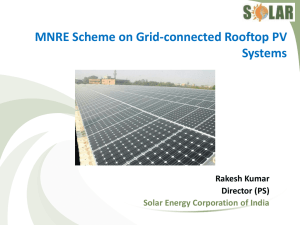Roof top Solar PV Systems
advertisement

Harnessing Solar Energy by Utilizing Rooftop Space of Railway Buildings Solar Energy Corporation of India 4th Floor, Tower 1, NBCC plaza Sector V, Pushp Vihar Saket, New Delhi-110017 SECI- Inception and Objectives OUR MANDATE: To be the implementing agency for meeting the National Solar A Government of India Enterprise under the administrative control of MNRE Mission objectives To plan and execute an integrated programme on development and Incorporated on 20th September, 2011 as a “Not for profit” Company under Section 8 of the Companies Act, 2013 deployment of solar energy technologies to achieve commercialization; Authorised capital INR 2,000 Crores; Paid up capital INR 42 Crores as on FY 2014-15 To own, operate and manage, both grid-connected & off-grid power stations; 13-Apr-15 SOLAR ENERGY CORPORATION OF INDIA To promote R&D in Solar 2 SECI Activities : Ongoing Broad mandate : Implementation & Facilitate various activities of the JNNSM. As part of the Mission activities SECI has taken up the following projects/ activities. 750 MW Grid connected solar power plants under JNNSM Phase II 4000 MW Ultra Mega Solar Power Plant in Sambhar, Rajasthan Pilot CSP Projects of around 100 MW Implementation of Grid Connected Solar Roof-Top scheme Development and dissemination of solar home lighting systems/ solar lanterns Solar Thermal installations for water/air heating Solar Mini/Micro Grids/street lights etc. R&D Projects 13 April 2015 SECI 3 Growth of Solar Capacity (MW) State Gujarat 2101 Solar Capcity (MW) 1684 936 3 11 36 2008-09 2009-10 2010-11 2011-12 2012-13 2013-14 % MWp 860.4 41.0% Rajasthan 656.15 31.2% Maharashtra Madhya Pradesh Andhra Pradesh Uttar Pradesh 207.25 9.9% 162.315 68.9 7.7% 3.3% 17.375 0.8% 28.18 1.3% Jharkhand 16 0.8% Karnataka 24 1.1% Orissa 15.5 0.7% Punjab 9.325 0.4% 7.8 0.4% West Bengal 7.05 0.3% A & N Island 5.1 0.2% Uttarakhand 5.05 0.2% Chhattisgarh 7 0.3% Delhi 2.6 0.1% Lakshadweep 0.8 0.0% Tamil Nadu Haryana Roof top PV-Towards grid parity Source:KPMG By 2017 roof top solar power cost will reach the grid parity. Benefits of Roof top PV • On national level, reduces requirement of land for addition of solar capacities. • For consumers, it – Reduces the dependency on grid power. – Mitigates diesel generator dependency. – Long term reliable power source. • For Discoms, it reduces – Day Peak load Demand – T&D and conversion losses as power is consumed at the point of generation. • Most suitable for commercial establishments – Max generation during peak usage time. – Solar power cost is close to the commercial power cost. SECI’s Grid Connected Rooftop Scheme Salient Features • MNRE launched a pilot scheme in year 2013 for grid connected rooftop PV power projects –being implemented by SECI • The scheme allows system size from 100 kW to 500 kW – Aggregation of capacity from smaller roofs is allowed. • 30% of the cost would be provided as subsidy and 70% to be met by the consumer • Systems are to be grid connected and without battery back up • Mostly in-house/captive consumption and to replace diesel generation • Surplus solar power to be fed to the grid • Cities across India being covered under the scheme for wider participation/promotion • Developers selected through a competitive process Implementation • Under the scheme SECI – Allocates capacity for each city/State in consultation with MNRE/SNAs – Verify project proposals w.r.t. technical specifications and release the sanction for subsidy which is linked to performance up to 2 years – Release initial subsidy on successful commissions as per technical specifications (20%) – Release 5 % subsidy each at the end of 1st and 2nd year of successful maintenance of the project – Help developers for identification of projects through dissemination workshops and to discuss any issues with concern authorities SECI’s Ongoing Scheme of Rooftop PV (Covering 37 Cities of India) Chandigarh (1) Mohali (1) Implementing Rooftop projects with 30% subsidy from MNRE 100-500kW capacity projects being set up in select cities Phase I: 5.5 MW (4 cities) Phase II: 11.3 MW (6 cities) Phase III: 10 MW (9 cities) Gurgaon (2.5) New Delhi (5) Jaipur (3.75) Gwalior (1) Noida/Greater Noida (3.5) Panchkula (1) Faridabad(0.5) Bhopal (1) Gandhinagar (1) Vadodara (0.5) Surat (0.5) Nasik (0.5) Legend Phase I Phase II Phase III Phase IV Multiple phases () Capacity in MW 13-Apr-15 Amritsar (0.5) Ludhiana (0.5) Nagpur (0.5) Mumbai (1) Pune (3) Tirupati (0.5) Bangalore (3) Coimbatore (1.5) SOLAR ENERGY CORPORATION OF INDIA Patna (2) Palatana (1) Ranchi (2) Kolkata (2) Durgapur (1) Bhubaneswar (1) Raipur (2.05) Vijaywada (0.5) Hyderabad (4) Chennai (6) Mysore (1) Madurai (0.5) 11 Grid Connected Rooftop Scheme of SECI • So far 27 MW is allotted under three Phases of the Scheme • Around 40 MW will be allotted in Phase IV of the scheme – Benchmark cost is Rs. 90/ Wp for PPP model (RESCO) ; on which 30% capital subsidy will be available from MNRE – Tariff based competitive bidding is experimented for RESCO model in Phase IV of the scheme which lead to solar tariff in general in range of Rs. 6.0 to Rs. 6.745 (Cap at Rs.6.75/kWh) – In Capex model Average price is Rs. 75/Wp; Breakeven 5 to 6 years Indian Railways - Rooftop Solar PV Potential • Roofs of Railway Stations • (On going discussions for rooftop SPV systems at New Delhi, Anand Vihar, Katra Railway Stations etc) • Railway Workshops, • Loco sheds, • Coach factories, • Residential Railway Colonies, • Office buildings, • Hospitals etc. Energy Utilization Pattern In Indian Railways • Electricity consumption: 16.6 billion units (14.16 billion units Traction, 2.46 billion unit for non traction) ~`~ 2500MW ~~ 3800 MW (peak) , (22 billion unit , 5000 MW XII Plan projected) • Electricity consumption(Non Traction) - workshop 25%, station and service building 35%, pumping 10%, domestic 30% • Share in total energy Consumption (NATIONAL) - 2 % • Share in total energy consumption of transport sector - 5 % ( 77 % diesel, 23 % electricity) • Share of energy in total operating cost of IR – 24% (18,000 Cr, 8700 Cr for Electricity) (87 % traction, 13 % non- traction) Energy Usage FOR • Rolling stock manufacture, maintenance and disposal • Train operation. • Infrastructure construction and maintenance • Administration of transport business. • Energy production and trade. TIME • 24 X 7 X 365 THROUGH • GRID Power+ DG Set + Renewable (very Low) Why Solar in Railways • Railway sector growth 8-9% • Progressive shift of freight traffic to railway • 80% of rail freight and 60% passenger traffic on electric energy by 2030 • Electricity demand to go 100 billion kWh by 2030 for railway sector alone in India • The current trends indicates constraints in indigenous availability of conventional energy resources • World trend to achieve min. 25% through RE by 2020 in transport sector leader Germany, Sweden, USA • Fuel diversity • No space constraint Railways Initiatives • Indian Railways Vision 2020-At least 10% of its total energy to come from renewable sources such as solar power, wind, and biomass etc.” (500MW) • Policy of solar based system for D and E class station, emergency light for all class of station(sep,12) • Achievement so far • 10.50 MW Wind • 4.50 MW solar • 4.69 MW solar PV Plant in progress Railways Initiatives • Solarization of unmanned Railway Crossings – For Optical fiber and Integrated Battery bank system – The system size ranges from 1400 Wp to 3500 Wp – More than 150 systems have been installed nation wide – The zone covered are Eastern, Nothern railway, Western railway and West central • Installation of 500 kWp size Rooftop at Katra Railway station in J&K within 3 to 4 months • Decided to take up rooftop PV projects at railway stations, workshops, loco sheds, hospitals ,offices and residential colonies etc Under Phase I of 500 MW across the country • Railways to share the details of rooftop space • SECI and IR may work together on a special scheme dedicated to Railways (in consultation with MNRE for CFA) and implemented through various business models including PPP mode • Major consumption by IR at respective locations and excess power only to flow to grid • Activity start up locations are New Delhi Railway station, Katra Railway Station, workshops at Dahod , Bhusaval, Chittaranjan locomotive works and Kanchanpara, • Innovative Pilot project of providing rooftop PV on one NonAC railway coach with thin film technology • SECI shall provide complete solution from Conceptualization, estimation, tendering, Implementation, monitoring, handholding and initial O&M support for these Solar Power Projects and activities for Indian Railways Criterion for Roof Selection for SPV Systems • In the ideal case SPV system should be mounted facing towards South direction • Roofs should have longer life and better load-bearing capacity • Structure should be strong enough to bear the load of the PV panels and the associate mounting systems • Roofs may be identified in the initial phase where commercial tariff is high and there is better promotional prospect Key Challenges Roof Assessment • Detailed structural analysis and wind load assessment is required to be carried out for realistic SPV design and engineering • It has been seen that most of the roofs comprise Asbestos Cement Sheets which are brittle in nature and not generally recommended for SPV systems • SPV systems should be installed on the roofs with metallic tops for longer life and better load-bearing capacity THANK YOU








